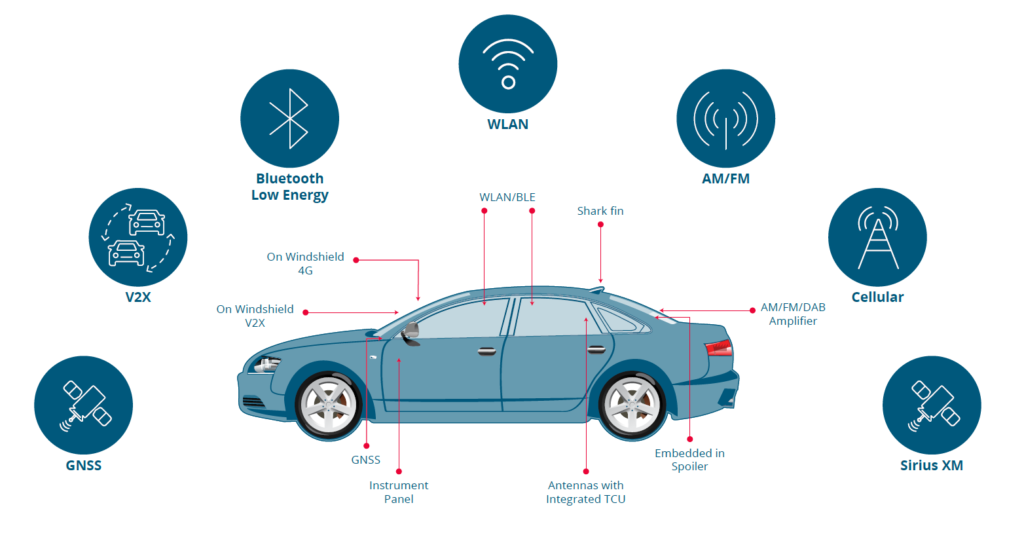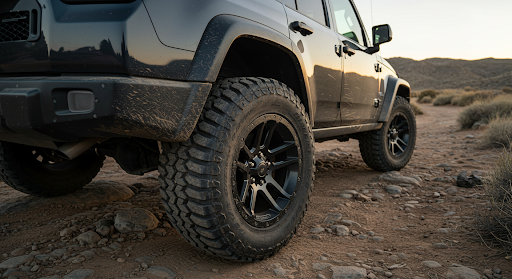
Today’s drivers are accustomed to losing radio or cell signals when entering a tunnel or remote area. But, as service levels improve in the future, they will demand more consistent experiences from their vehicles. Fortunately, industry collaborations and technology breakthroughs are making significant advancements in vehicle-to-everything (V2X) connections, including vehicle-to-network (V2N) connectivity. Vehicles now sport a bevy of sensors and antennas to better communicate with the world around them. Still, major technological hurdles must be cleared to realize the full promise of connecting and communicating with “everything.”
To make ubiquitous connectivity a reality, vehicle designs must support always-available V2X and V2N operations, enabling everything from enhanced vehicle safety and operation to next-gen navigation and infotainment systems. As losing connections will no longer be an acceptable part of driving, manufacturers and suppliers must focus on delivering unblinking levels of connectivity. As vehicles of tomorrow seamlessly communicate with the digital environment, the role of antennas also becomes increasingly crucial.
Let’s explore what must be accomplished by focusing on the three C’s: connectivity, capacity and coverage.
Connectivity Maximizes Performance
Today, most of the miles we drive are serviced by the terrestrial cellular network connected to 4G or 5G systems. The challenge for the future is optimizing data rates to support V2X and V2N connectivity for all vehicles. The solution is to employ 5G FR1 multiple-in multiple-out (MIMO) technology.
The goal of MIMO technology is to turbocharge cellular connectivity by leveraging multiple optimized antennas connected to one or more cellular modems. The FR1 frequency band (410 MHz to 7.125 GHz) optimizes 4G ,5G and in-future 6G performance. With MIMO, vehicles of tomorrow will minimize errors, optimize data speeds and improve the capacity of wireless transmissions by enabling data to travel over multiple signal paths concurrently. MIMO creates multiple copies of the same signal to allow additional opportunities for signals to connect with receiving antennas with limited fading. This also improves signal-to-noise ratios and reduces error rates.
MIMO boosts throughput of cellular connectivity systems to create connections that are more stable and less congested. To accomplish this, however, alterations are required to the electronics architecture of vehicle antennas. What’s needed is a vehicle distributed antenna system (vDAS) that connects multiple antennas via analog or digital interfaces, with the latter becoming standard in the future.
Signal quality and speed of 5G FR1 MIMO in regions with cellular coverage will empower increased communications levels and a broader range of in-vehicle functionality. Adopting vDAS architecture lets this capability be ingrained into vehicles, which enables antenna technology targeted to overcome capacity challenges.
Capacity Delivers Network Access in Dense Environments
In densely populated areas, like urban centers, airports, sports venues and well-traveled roadways, cellular network coverage is nearly universal. The challenge in these areas, however, is capacity. With current connectivity and network speeds, vehicles can lose service even when cellular signals are available because of network overloading.
In these environments, the solution is 5G mmWave technology. Utilizing the large 5G FR2 frequency bandwidth available between 24.25 and 52.6 GHz, mmWave provides speeds that are four to five times faster than low- or mid-band FR1. This facilitates noticeable improvements in performance and network utilization. Increasing data rates, reducing latency and closing coverage gaps can be accomplished — even under heavy network loads — with mmWave. The one limiting factor is operating range, which is restricted to less than one kilometer. But for applications in most urban areas, this is an acceptable trade-off.
Utilizing mmWave requires precisely aligned antenna arrays, which use digitally controlled beamforming tracking and steering to improve signal reception and help cancel interference. Beamforming involves focusing and directing signal beams by changing the phase of input signals on arrays’ radiating elements. This capability improves range and signal integrity but requires high-speed interfaces and high-performance signal processing within vehicles to create a control loop that can monitor and adjust the beamforming setting to optimize performance and signal strength.
Phased array mmWave antennas utilize a miniaturized form factor with scalable, modular variants for mounting in different areas of vehicles. Digitally controlled beamforming lets vehicles maintain constant high-speed connectivity even in the most congested urban areas.
Coverage Eliminates Network Gaps
In the future, network coverage must expand beyond the terrestrial network (TN) to the non-terrestrial network (NTN), which offers broadband satellite-based connections. The NTN can provide coverage for hundreds of kilometers, delivering connectivity in rural and remote areas, even those that are both high and hot. The NTN also is indispensable during public safety emergencies when TN communications may be affected.
The NTN comes in two flavors: the NTN-IoT (Internet of Things) offers a narrow band and low data rate or wideband with enhanced data rates while the NTN-NR (New Radio) provides broadband access and fast, reliable and efficient wireless access in remote areas. NTN-NR relies on beamforming antennas to improve signal-to-noise ratios and reduce interference in crowded environments. Communications satellites move overhead in orbit, creating a “constellation” of signal sources. Each satellite operates relative to the Earth’s surface and beamwidth changes with elevation angle. For vehicles, beamforming and steering — digitally controlled via a control/steering loop — adjust to changing beamwidths.
While an important factor for tomorrow’s vehicles, NTN connectivity is not without challenges. Maintaining line-of-sight visibility can be an issue when the satellite is just above the horizon. Satellites’ constant movement also creates a Doppler effect, which can result in high shift and variation rates. Signal amplitude and phase can experience rapid fluctuations due to atmospheric and weather-related influences. Yet with sufficient satellite coverage, NTN communications offers high data speeds to vast areas not covered by TN coverage.
Synergies and Opportunities
Automakers and their suppliers need to collaborate on how best to integrate solutions into vehicles cost effectively and efficiently. Different antennas being mounted throughout vehicles, along with processors to operate them, present challenges due to the number of components that must be packaged and fitted into each body and incorporated into the vehicle’s wiring architecture.
As the number of in-vehicle electronic devices increases, electrical/electronic architectures are undergoing a transformation from domain-based systems to zonal systems. Zonal architecture simplifies cabling and lowers the costs of wiring harnesses and installation by dividing vehicles into zones, each with its own zonal controller. Individual devices, such as antennas, can be connected to the nearest zonal controller, rather than going “old school” and connecting all devices to a central processing unit.
Molex, a global leader in sharkfin, hidden and interior antennas for 5G connectivity, is combining its expertise in multiple fields, such as mmWave and MIMO, to create industry-leading connectivity solutions. The company’s MX-DaSH line of hybrid connectors, for example, eases the transition to zonal by combining power and signal circuits, along with high-speed data connections, in a single, multipurpose connector.
These changes require digital, rather than analog, interfaces between devices and controllers. Going digital yields multiple advantages, including loss-less RF signal transmission and less expensive harnesses as well as smaller space requirements with thinner cables replacing heavy coaxial ones. Digital interfaces also allow more antennas, which permits vDAS implementation without adding weight or wiring harness complexity.
Auto manufacturers and their suppliers must adopt a holistic approach to V2X integration to address the challenges and meet the demands of today’s consumers for ubiquitous connectivity in tomorrow’s vehicles.
Author bio: Florian Scherbel is Director of Product Management for Molex.









More Stories
Dürr and GROB concept battery factory uses 50% less production space
DuPont materials science advances next generation of EV batteries at The Battery Show
Cybord warns of dangers of the stability illusion